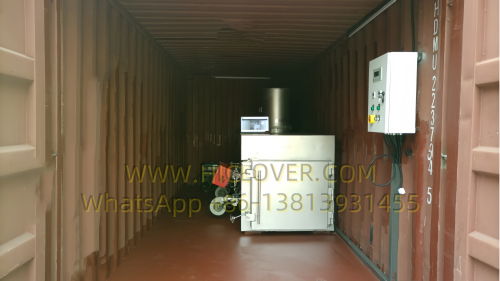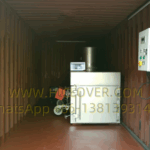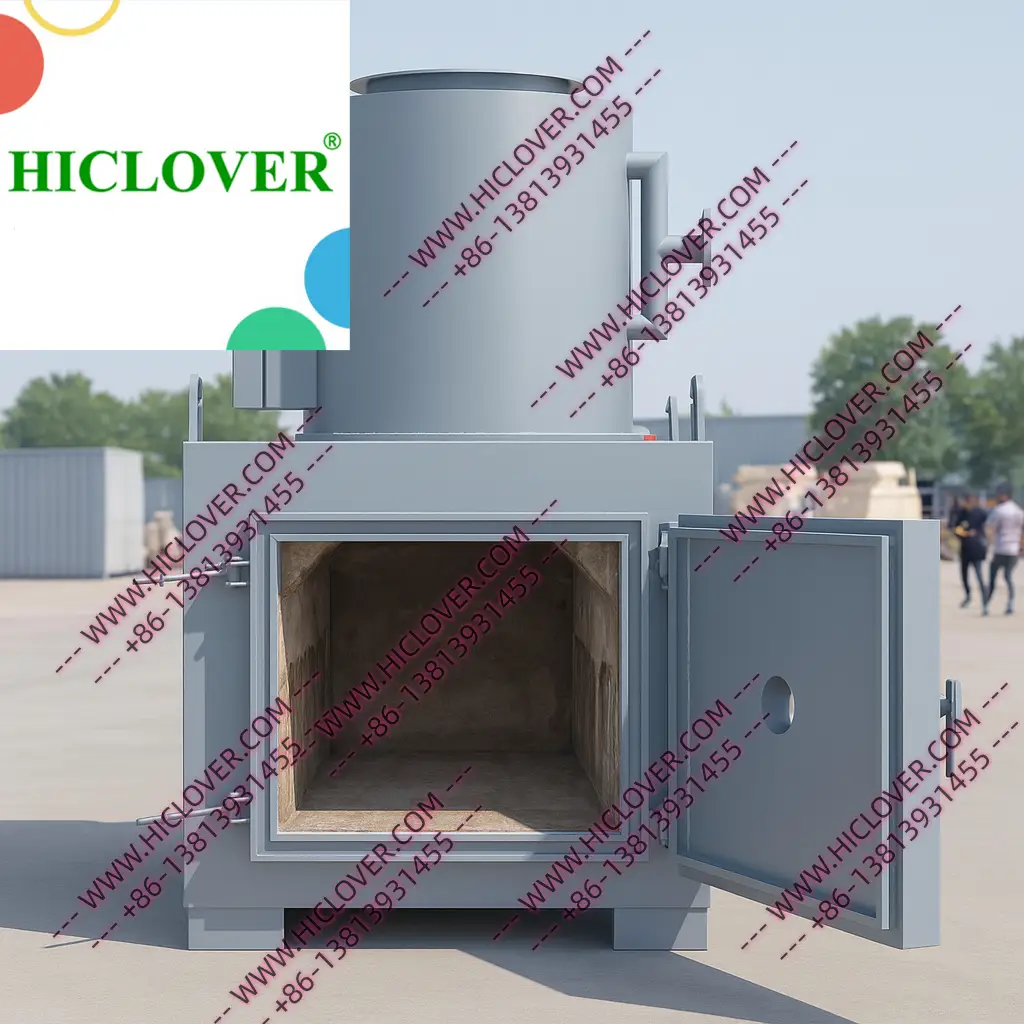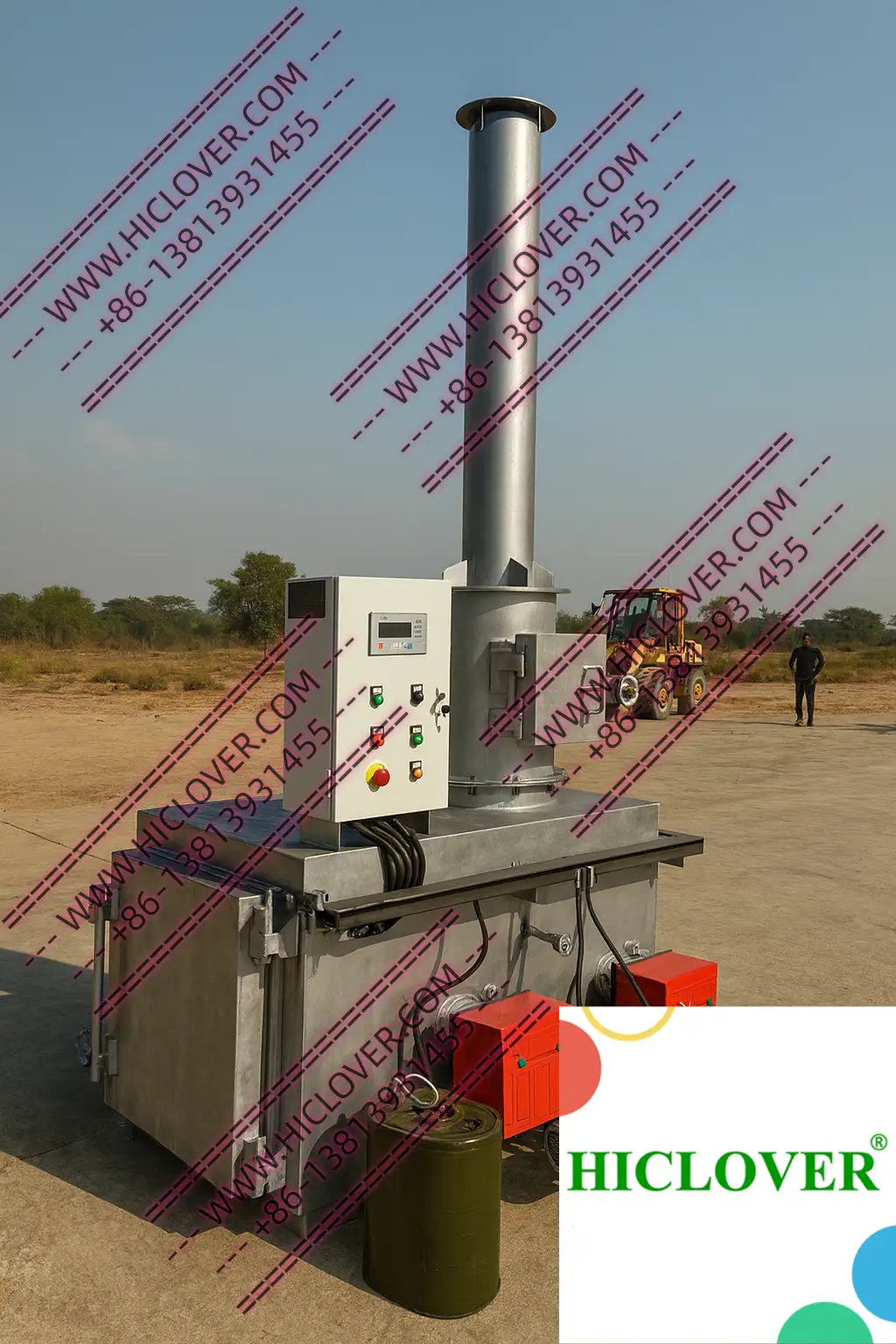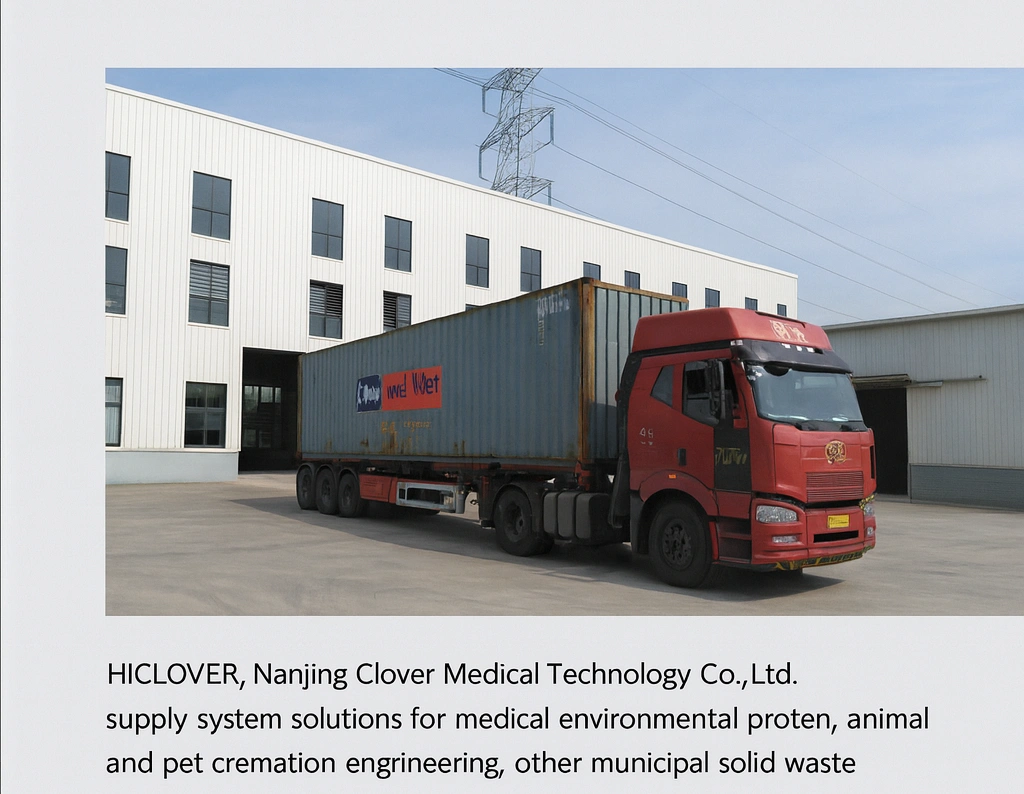Containerized Mobile Incinerators for Hospitals, Clinics, and Camps
Effective waste management in diverse settings – from hospital waste disposal to remote field camps – calls for incineration solutions that are both mobile and robust. HICLOVER’s containerized incinerators (HICLOVER) are built to meet these needs with portable designs and advanced combustion technology. Whether it’s a hospital waste containerized incinerator 100 kg per hour for a city hospital or a mobile incinerator for rural clinics and camps, HICLOVER provides solutions that combine high capacity, compliance with emissions standards, and ease of deployment. These units come pre-assembled in ISO shipping containers for quick plug-and-play setup, requiring no permanent infrastructureethiopia-incinerator.com. The result is a flexible waste treatment system that can be rapidly deployed or relocated as needed – from local healthcare facilities to solid waste treatment in African petroleum camps.
Hospital Waste Incinerator – 100 kg/hour Containerized Unit
Hospitals and large clinics generate infectious and biomedical waste daily that must be disposed of safely. A containerized incinerator with about 100 kg per hour burn rate (such as HICLOVER’s Model TS100 PLC) is ideal for hospital waste managementhiclover.comhiclover.com. These incinerators are designed as dual-chamber systems: the primary chamber achieves high temperatures (800–1000 ℃) to burn medical waste, and the secondary chamber reaches 1000–1200 ℃ with at least a 2-second gas retention to destroy harmful emissions like dioxinshiclover.comrfq.hiclover.com. The CA100 unit, for example, features a 1200 L primary combustion chamber and a 600 L secondary chamber, ensuring complete burnout of sharps, pathological waste, and other hospital refusehiclover.comhiclover.com.
Each HICLOVER medical incinerator comes equipped with a PLC automatic control system for safe and consistent operationrfq.hiclover.com. The PLC (Programmable Logic Controller) allows automated control of burner ignition, temperature, and cycle times, reducing the need for constant human monitoring. Intelligent sensors and safety interlocks are integrated to protect operators – for instance, the system can automatically shut off burners when the loading door is opened and then re-ignite once the door is closed, enabling continuous feeding without hazardincinerator.co. With features like digital temperature displays and automatic temperature protection, the incinerator maintains the required high temperatures (typically 800–1200 ℃) for effective pathogen destructionhiclover.comhiclover.com.
Crucially, HICLOVER’s containerized hospital waste incinerators are built for easy installation and mobility. Housed in a standard 20 or 40 ft container with thermal insulation, they require no concrete foundation and can be operational shortly after arriving on siteethiopia-incinerator.com. This is particularly useful for emergency situations or expanding hospital facilities, where an incinerator can be delivered and made operational immediately. For example, TS100 can be transported to a field hospital or an urban medical center and quickly connected to fuel (diesel or gas) and power to start processing wasteethiopia-incinerator.comincinerator.co. The self-contained design also improves safety and cleanliness, confining the incineration process within a secure steel container and keeping it isolated from staff and patients.
Mobile Incinerator for Rural Clinics and Camps
Rural clinics, small hospitals, and field camps often lack access to centralized waste treatment plants. In these settings, a mobile incinerator for rural clinics and camps can be a lifesaver for proper biomedical waste disposal. HICLOVER addresses this need by offering incinerators mounted in containerized units or on trailer/skid bases, making them highly portable for remote areascovid19.africa-incinerator.com. These mobile incinerators range in capacity – smaller models like the HICLOVER TS30 PLC handle about 30 kg/hour and are well-suited for rural health centers, while larger portable units can manage 60–100 kg/hour for bigger clinics or temporary medical campscovid19.africa-incinerator.com.
Even the smaller incinerators incorporate the same critical features as larger units. They use twin combustion chambers with PLC automationcovid19.africa-incinerator.com to ensure complete burning of medical waste and minimal emissions. The dual-chamber design (primary and secondary) guarantees that sharps, dressings, and infectious materials are thoroughly incinerated, and harmful pollutants are broken down at high temperaturescovid19.africa-incinerator.com. This is essential for rural clinics dealing with sharps waste – used needles and syringes are safely destroyed so they cannot be scavenged or reused, preventing the spread of diseases like HIV and hepatitiscovid19.africa-incinerator.comcovid19.africa-incinerator.com.
Mobile HICLOVER units for rural applications are built with user-friendly and safe operation in mind. They often feature a front or side loading door with protective mechanisms for the operator. The control panel (usually PLC-based) allows even a small staff to run the incinerator with minimal training, and some models have progress display screens and timers to monitor incineration cycles. Fuel flexibility is another advantage in remote areas – HICLOVER incinerators can operate on diesel, and many models can be optionally configured for dual-fuel (diesel or natural gas) depending on local fuel availabilitycovid19.africa-incinerator.com. This ensures that a clinic in a village with only diesel supply, or a camp with LPG, can reliably use the incinerator.
For deployments by NGOs or military camps, the mobility and quick setup of these incinerators are key. The entire system can be crane-lifted and trucked to a new location as neededincinerator.co. In fact, HICLOVER’s containerized or trailer-mounted incinerators have been used in UN health missions and disaster relief operations where a rapid response is requiredincinerator.co. Units like the TS30 PLC models are plug-and-play, meaning once on site, they only need basic connections to start – no lengthy construction or installation. This ease of deployment has made HICLOVER incinerators popular for rural healthcare projects funded by organizations like WHO and the World Bank, which often specify dual-chamber, high-temperature incinerators for improving medical waste management in developing regionscovid19.africa-incinerator.comcovid19.africa-incinerator.com. Indeed, Tanzania’s national health initiatives, for example, have adopted modern containerized incinerators for laboratories and rural clinics to replace outdated open burning, with HICLOVER units meeting the required NEMC environmental guidelinescovid19.africa-incinerator.comcovid19.africa-incinerator.com.
HICLOVER Containerized Incinerators in African Petroleum Camps
Remote oil and gas exploration sites and African petroleum camps present a unique waste management challenge. These camps generate a mix of wastes – from daily garbage and kitchen waste to oil-contaminated rags, drilling fluids, and even hazardous materials – all in isolated locations far from municipal disposal facilitiesincinerator.co. HICLOVER containerized incinerators for solid waste treatment in African petroleum camps have proven vital in maintaining cleanliness and environmental compliance on these sites. For example, in the Libyan oil fields, HICLOVER’s larger models like the TS300 PLC and TS500 PLC are deployed to handle industrial-scale waste volumes. Shipped fully assembled in ISO containers, these systems offer plug-and-play deployment with no need for civil works, allowing oil companies to rapidly set up waste incineration at remote drilling campsethiopia-incinerator.comethiopia-incinerator.com. This portability means an incinerator can move as the project moves – a valuable feature in exploration phases or temporary rig camps.
The incinerators for oilfield applications are engineered for harsh environments and heavy-duty use. The container housing is reinforced and insulated to withstand extreme heat and desert conditions (e.g. high ambient temperatures, sandstorms)ethiopia-incinerator.com. Burners are high-capacity (often imported from Italy for quality) and built to endure continuous operation, since oil camps may incinerate waste around the clockethiopia-incinerator.comcovid19.africa-incinerator.com. HICLOVER’s designs also incorporate corrosion-resistant coatings to protect against the elements, ensuring a long service life even in humid or coastal oilfield environmentsethiopia-incinerator.com.
medical compliance is a top priority in petroleum camps. International oil companies and their contractors must meet strict environmental regulations and ESG (medical, Social, Governance) goals. HICLOVER’s dual-chamber incinerators help meet World Bank IFC emissions guidelines and WHO biomedical waste standards by achieving high combustion efficiency and clean emissionsethiopia-incinerator.com. The secondary combustion chamber and high-temperature operation (often above 1100 ℃) ensure that smoke and harmful gases are thoroughly treated before release. Many units come with or can be fitted with optional air pollution control devices, such as wet scrubbers and particulate filters, to further reduce acid gases and dust in the exhaustincinerator.coincinerator.co. These scrubbers neutralize acidic components like HCl and SO₂ and capture fine particulates, a feature particularly useful if the waste stream includes chlorine-containing plastics or other chemicalsrfq.hiclover.comrfq.hiclover.com. By using such emission control add-ons, oil and gas operators in Africa have been able to adhere to environmental standards even when incinerating mixed waste streams on-siteincinerator.coincinerator.co.
In practice, HICLOVER’s containerized incinerators have become a standard solution for oilfield camps in countries like Libya, Nigeria, Uganda, and Angola. They offer high throughput (some models can burn 300–500 kg/hour) with optimized fuel consumption, an important factor for cost-conscious operationsethiopia-incinerator.com. For instance, the TS500 PLC unit not only destroys waste at high volumes but does so with a fuel-to-waste ratio engineered for efficiency, helping reduce diesel usage over timeethiopia-incinerator.com. Major petroleum companies and national oil corporations have chosen HICLOVER incinerators to improve on-site waste management as part of their sustainability effortsethiopia-incinerator.comethiopia-incinerator.com. By integrating these incinerators, camps keep their waste under control (minimizing open dumping or pit burning) and demonstrate compliance with environmental commitments – all while having a system that is mobile and can be redeployed to new drilling sites as needed.
Key Technical Features and Options of HICLOVER Incinerators
One of the reasons HICLOVER’s incinerators are suited to such a wide range of applications is their advanced technical features and configurable options. All models are designed as high-temperature, dual-chamber incinerators with refractory lining, ensuring efficient primary combustion and a secondary burn to treat exhaust gasesrfq.hiclover.com. High-Temperature Retention (HTR) technology is built-in – the secondary chamber maintains a high temperature (often 1100 ℃ or higher) with a minimum 2-second residence time to achieve near-complete combustion of organic pollutantscovid19.africa-incinerator.comcovid19.africa-incinerator.com. This results in smokeless operation and compliance with international emission standards for medical and solid waste incineration.
PLC Automatic Control: As a standard, HICLOVER provides PLC-based control systems on its incinerators, which automate the burn cycle and safety functionsrfq.hiclover.com. Operators can switch between manual and automatic modes (dual control mode) as needed. In automatic mode, the system manages burner operation, temperature set-points, and timers. The PLC also enables features like automatic ignition, shutdown and restart sequences, and fault alarms. For example, if any parameter goes out of range or a door is opened unsafely, the PLC triggers an automatic alarm and safe shutdown, alerting the operator with visual and audio warnings (an “automatic false alarm” system for safety) before conditions are restored. This level of automation and self-monitoring increases reliability, especially important in remote areas where technical supervision may be limited.
Burner Quality and Fuel Options: HICLOVER incinerators use high-quality burners (often imported Italy-made burners) to ensure consistent and efficient combustioncovid19.africa-incinerator.com. These burners are designed for longevity and easy maintenance, capable of running on different fuels. Diesel-fueled burners are standard, but many models offer dual-fuel capability, allowing the incinerator to run on diesel or natural gas/LPG as availablecovid19.africa-incinerator.com. This dual-fuel option provides flexibility and can lower operating costs if a cleaner or cheaper fuel is accessible. Additionally, an intelligent fuel-saving feature is available on some models: through the PLC and sensor feedback, the burner modulates flame intensity to maintain temperature with optimal fuel use (preventing excessive fuel burn once the chamber is hot, which is a form of heat recovery efficiency).
Optional Enhancements: HICLOVER offers a wide range of optional features to tailor the incinerator to specific needs:
-
Mobility Customization: Beyond the base containerized design, units can be ordered on trailer chassis or skid/sledge frames for easier towing or dragging in off-road conditions. This is useful for military, mining, or construction camps where incinerators might need to be moved frequentlycovid19.africa-incinerator.com. Lightweight modifications are available for easier transport, and crane hooks or forklift pockets are built into container models for handlingincinerator.co.
-
Feeding and Ash Handling: While standard models have a manual loading door (usually side or front), there are options for top-loading doors or automatic feeding systems for continuous operation. For high-throughput scenarios, an automatic waste feeder (e.g. a conveyor or bin tipper) can be integrated to continuously add waste without cooling the chamber. Similarly, automatic ash removal systems (like ash conveyors or detachable ash pans) can be included, so the burnt residue can be removed without interrupting operations. A movable grate or waste bed is another option that improves airflow around the waste and allows easier removal of ash by simply rolling out the grate.
-
Advanced Combustion and Heat Recovery: HICLOVER’s engineering includes options like Heat Heart Technology (HHT) – an optional feature focusing on enhanced heat distribution and combustion efficiency – and pre-heat/heat recovery systems. Heat recovery can be used to preheat combustion air or waste fuel, effectively recycling heat to save fuel (a fuel-saving mode) and improve overall energy efficiency. For instance, exhaust heat exchangers can preheat incoming air or even produce hot water/steam for use elsewhere on a site, turning the incinerator into a part of a broader energy management system.
-
Emission Control: In addition to wet scrubbers, clients can opt for dry filtration systems such as baghouse filters or cyclonic dust separators after the scrubber to capture any remaining particulates (a sort of “smoke dust filter” system). For medical waste, activated carbon injection systems can also be provided to adsorb volatile toxins like mercury or dioxins if neededcovid19.africa-incinerator.com. High chimneys or stack extensions are available to ensure adequate draft and dispersion of cleaned flue gas. All incinerators come with temperature monitoring and recording options – enhanced thermocouples (often with a corrosion-resistant corundum probe rated to 1600 ℃ for longevity) monitor the chambers, and data loggers can record temperature profiles for compliance reporting.
-
Convenience & Safety: Features like a flame observation window (a small reinforced glass porthole to observe the burner flame and combustion process) can be included to aid operators. System self-testing modes are integrated via the PLC so operators can run diagnostics on sensors and actuators before each use. For maintenance and support, HICLOVER supplies spare parts kits and offers operator training along with personal protective equipment (PPE) kits for incinerator operators. These PPE kits typically include heat-resistant gloves, face shields, and coveralls, ensuring safety during loading and ash removal.
With such technical features, HICLOVER’s containerized incinerators are able to serve varied applications. A small rural clinic unit might prioritize easy operation and sharps disposal safety, while a large oil camp unit might be outfitted with extra fuel capacity and scrubbers – yet both are based on the same proven dual-chamber, high-temperature design. The flexibility in configuration means customers can specify the incinerator model and options that match their waste volume and regulatory requirements.
HICLOVER’s containerized and mobile incinerators have become trusted solutions for effective waste treatment across hospitals, rural communities, and industrial camps. By combining modular design, advanced combustion engineering, and mobility, these incinerators enable on-site waste disposal that is efficient, compliant, and secure. A single HICLOVER unit can be destroying infectious hospital waste at 100 kg/hour in one regionhiclover.com, while another is eliminating trash in a remote oilfield camp with minimal environmental footprintethiopia-incinerator.com. In all cases, the core benefits remain consistent: rapid deployment, reliable high-temperature performance, and adherence to strict emissions standards.
From UN field hospitals in Africa to petroleum exploration camps and municipal clinics, HICLOVER’s containerized incinerators are field-tested and globally deployed solutionsincinerator.co. They exemplify how modern incineration technology – featuring containerized mobility, double-chamber combustion, PLC automation, and optional enhancements like scrubbers or heat recovery – can tackle waste challenges anywhere. As organizations and governments seek safer and greener waste management, the HICLOVER brand stands out with portable incinerator systems that bring “clean and efficient waste treatment” directly to the point of need. Whether referred to as a mobile incinerator in English, HICLOVER’s innovative incineration solutions continue to support public health, environmental protection, and operational efficiency around the world.
